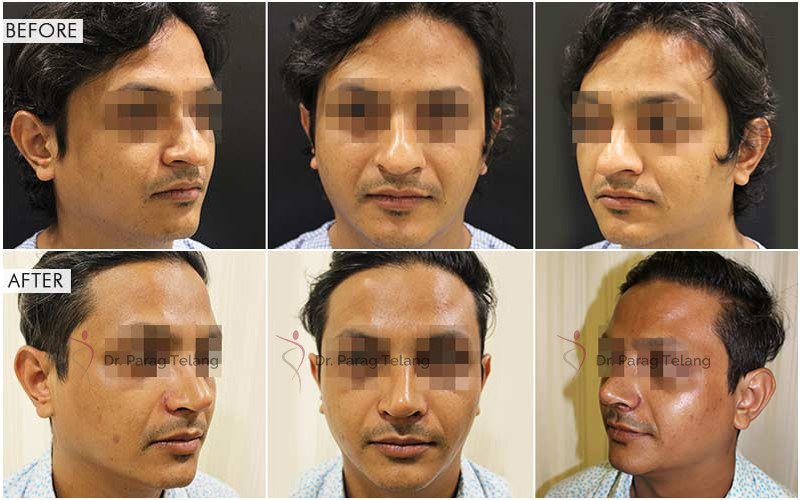Rhinoplasty in India
Are you unhappy with your facial appearance because of the shape or size of your nose? You don’t have to feel self-conscious about a nose that seems out of balance with your facial features. A cosmetic rhinoplasty in India can help enhance your nose shape and bring overall facial harmony.
If you experience breathing difficulties due to a crooked or deviated nose, you may benefit from a combined functional and cosmetic rhinoplasty to improve both appearance and nasal function.
At Designer Bodyz, we offer the best and most affordable nose job surgery in India, performed by the highly reputed plastic and cosmetic surgeon Dr. Parag Telang. Schedule your consultation today to discuss your desired results and treatment options.
What is Rhinoplasty?
Rhinoplasty, commonly referred to as nose job, is a nose reshaping surgery- a type of plastic surgery that aims to modify the nose shape, size, or symmetry. Rhinoplasty surgery is usually performed for cosmetic purposes but may even be carried out for medical purposes- to improve nose functioning by fixing nasal septum deviation. In some cases, Rhinoplasty- a nose surgery is chosen for both cosmetic and functional reasons.
Reasons for Rhinoplasty (Goals of Rhinoplasty)
The purpose of a rhinoplasty can be cosmetic or functional. A common rhinoplasty aims to improve nose aesthetics.
Here are some cosmetic indications- the popular reasons for getting rhinoplasty:
- Removal of a nose hump
- Reshaping of the nasal tip
- Straighten crooked nose
- Alteration in the size/width of the nostrils
- Correct congenital structural nose defects
- Repair the damaged nose caused by an injury or cancer/severe infection
- Alteration in size of the nose to make it in balance with other facial features.
Here are the medical indications for rhinoplasty- the conditions treatable with rhinoplasty:
- A cleft lip
- Apert Syndrome
- Hemangiomas
- Frontonasal dysplasia
- A deviated nasal septum
- Treacher Collins Syndrome
- Craniosynostosis- early fusion of joints in the baby’s skull.
Types of Rhinoplasty Surgery
Typically, surgeons classify rhinoplasty surgery into two types, based on where the incisions are made:
- Open rhinoplasty- The surgeon gets complete access to the internal nasal structure through an incision made across the columella- the tissue that separates the nostrils. This is preferred for major alterations of the nose.
- Closed rhinoplasty- The surgeon makes incisions only within the nostrils to separate the nose skin from bones and cartilage lying underneath. This is preferred for minor alterations of the nose.
Within these two types, come other rhinoplasty surgery types, based on their purposes:
- Tip plasty (nose tip rhinoplasty)- This is a nose surgery that focuses only on reshaping/resizing the nose tip.
- Septorhinoplasty- It is a combination of cosmetic and functional rhinoplasties where an incision is made in the nose lining to remove bent bones and cartilages; straighten and narrow the nasal bones; and support/rebuild a damaged/deformed part of the nose.
- Revision rhinoplasty- Also referred to as second rhinoplasty, this is the nose surgery that is done to fix cosmetic or functional issues that arise after a first nose job.
Candidate for Rhinoplasty in India
Rhinoplasty is an elective surgery that one must get done for one’s own sake, not to solely satisfy other’s desires or try to fit into an ideal image. To confirm whether one is a candidate for rhinoplasty, one should consult with a plastic surgeon.
Most suitable candidates for rhinoplasty include:
- People with good general health
- Individuals with complete facial growth
- Individuals who hold realistic goals and expectations and a positive outlook regarding what they can achieve from rhinoplasty
- People who are willing to go under the knife, for a lengthy recovery, and experience certain side effects.
Rhinoplasty should not be undertaken by:
- Smokers
- Drug addicts
- Individuals with sleep apnea
- Patients with bleeding disorders
- People whose noses have not attained adult-size
- Those who had undergone a rhinoplasty within the past one year
- Patients suffering from psychiatric conditions like body dysmorphic disorder.
Benefits of Rhinoplasty Surgery
- Functional Benefits- Improved breathing and reduced sinus issues.
- Aesthetic Benefits- Enhanced facial harmony, corrected nasal deformities, improved appearance.
- Psychological Benefits- Overall satisfaction, improved confidence, and better mental well-being.
Consulting a Plastic Surgeon for Rhinoplasty
When deciding to go for a nose job in India, it is important to schedule a rhinoplasty consultation with the best nose job surgeon, Dr. Parag Telang, at an accredited facility like Designer Bodyz to get a complete understanding of the surgery.
During a meeting with the best rhinoplasty surgeon, the patient must be prepared to discuss about:
- The surgical goals and expectations
- Current intake of medications and supplements
- Whether having an addiction to alcohol, drugs, and tobacco
- Any medical conditions, drug allergies, and previous medical treatments or surgeries.
The surgeon also:
- Provides a treatment plan
- Evaluates general health status
- Takes measurements of the facial features
- Talks about options available for reshaping the nose
- Clicks photographs of the nose from different angles
- Gives details of the procedure, benefits, and potential risks or complications.
Diagnosis Before Nose Job
Here’s what one needs before a nose job in India:
- A review of medical records
- Physical examination
- Pre-operative evaluation tests including blood tests, imaging tests, and others
- All of these actions before rhinoplasty surgery help the surgeon in creating and executing an appropriate surgical plan.
Before a Rhinoplasty: How to Prepare?
To well prepare for rhinoplasty surgery, here are some steps to take:
- Refrain from smoking
- Avoid vigorous physical activities
- Follow pre-anesthesia instructions
- Have a healthy, soft, light diet, and drink plenty of water
- Avoid intake of blood thinners and take only doctor-prescribed drugs.
Procedure of Rhinoplasty Surgery in India
Here are the steps of a rhinoplasty operation:
1. Giving Anaesthesia.
Local or general anesthesia or intravenous sedation, as the anaesthesiologist recommends, is administered to ensure a comfortable rhinoplasty procedure.
2. Making the incision.
Based on the chosen rhinoplasty technique- open or closed, an incision is made to separate the skin covering nasal bones and cartilage.
3. The nose structure modification.
As per the structural abnormality or defect of the nose, the surgeon may reduce, remove, or reposition bones and cartilage or add cartilage grafts. If a deviated septum, the nasal septum is straightened.
4. Closing the incision.
Once the nasal bones and cartilages are altered and the nose is sculpted to the desired shape and size, the remaining nasal skin and tissue are re-draped over the new nose contour, and the incisions are closed with absorbable stitches.
5. Waiting for the results.
Just after the nose job procedure, splints, and gauze packing are provided to support and protect the newly sculpted nose as it heals.
After a rhinoplasty: Self-care After Rhinoplasty
It is important to properly take care of your nose after surgery to quickly and smoothly recover from rhinoplasty.
Here are the surgeon-provided instructions on aftercare for rhinoplasty and what to expect at home during rhinoplasty recovery:
- Avoid wearing glasses
- Avoid heavy weight lifting
- Wear a nasal splint for the first week
- Avoid contact sports hitting on the face
- Return to normal routine within 2-3 weeks
- Avoid exposing the nose to direct sunlight
- Wear loose clothing, no over-the-head clothes
- Manage post-procedural pain with prescribed painkillers
- Don’t wear glasses or put excessive pressure on the nose
- When the nose is bandaged, take baths and not showers
- Keep your head raised while sleeping for at least the first 24 hours
- Avoid intense physical activities including swimming for 3 to 6 weeks
- Avoid blowing the nose and sneezing or coughing with your mouth closed.
Rhinoplasty Side Effects & Potential Complications
Just like any other surgery, there are some after-effects of nose surgery. One can expect the following rhinoplasty side effects, and the common risks of rhinoplasty surgery:
- Swelling
- Bruising
- Bleeding
- Infection
- Unsatisfactory results
- Anaesthesia-related risks
- Numbness of the nose or upper lip
- Temporary nose skin discoloration
- Mild to moderate pain or discomfort
- A sensation of blocked nose or trouble breathing.
The side effects of a nose job or complications after rhinoplasty can be minimized by choosing the right surgeon, ensuring candidacy for the surgery, and adhering to proper follow-up care instructions. Rarely experienced nose lift side effects include nasal obstruction, scarring, skin necrosis, and septal perforation.
Rhinoplasty Cost in India - Nose Reshaping
A rhinoplasty cost in India or the payable cost to reshape your nose widely varies from one city to another, the surgical centers, and the rhinoplasty surgeons. The individual factors on which the price of nose correction depends include the patient’s age, condition, and chosen surgery type as well as the procedure complexity. One should even factor in the expenses of pre-operative evaluations, follow-up care, and anesthesiologist fees.
To know your surgery's exact cost, schedule an initial consultation with Dr. Parag Telang today.
Rhinoplasty in India Before and After

*Opinion / Results may vary person to person.

*Opinion / Results may vary person to person.

*Opinion / Results may vary person to person.
FAQs About Rhinoplasty in India
When will I see the results of rhinoplasty?
Rhinoplasty starts showing results within a few weeks but the desired outcome takes up to one year to show up when the nose has completely healed.
How long does the rhinoplasty result last?
Rhinoplasty surgery is a permanent alteration of nose features, so the results last for one’s lifetime. In the case of liquid rhinoplasty, the results last anywhere from 6 months to 2 years.
Is rhinoplasty painful?
As rhinoplasty is typically carried out under the effect of local anesthesia, it isn’t painful. However, there is post-surgical pain that can be managed with pain-relieving medications.
Which is better: open or closed rhinoplasty?
Both types of rhinoplasties have some perks and drawbacks. The better option is decided by the surgeon based on the patient's needs.
For how long will the swelling remain after rhinoplasty?
Post-rhinoplasty swelling subsides within a few months but completely resolves in 12 to 18 months.
Are scars noticeable after rhinoplasty?
The surgical scars are minimal and remain hidden as the rhinoplasty incisions are typically made inside the nostrils, along the nose's natural creases.
When can I wear glasses after rhinoplasty?
You can typically start wearing glasses in 4 to 6 weeks when your nasal bones and cartilage have healed. But you should take your surgeon’s permission before you do so.
What’s the difference between rhinoplasty and septoplasty?
The difference between Septoplasty and Rhinoplasty is that both these nose surgeries have different purposes and outcomes. Rhinoplasty alters nose shape, size, or symmetry to correct nose defects, improve nose profile, or restore nasal features after an injury. Whereas, septoplasty only fixes the deviated nasal septum and helps ease breathing. One may need a rhinoplasty septoplasty or a combination of both. Which one is best is decided by the surgeon, as per the patient's needs.
Are there any alternatives to rhinoplasty surgery?
Yes. Liquid Rhinoplasty (the nose fillers), nose thread lift, nose shaping tools, and radiofrequency rhinoplasty are surgical rhinoplasty alternatives- the non-surgical rhinoplasty options, that can help bring changes to nose contours.
To get more details on nose job surgery in India and to correct the nose cosmetic issues, book a visit with the nose job surgeon, Dr. Parag Telang today!
Clinic Timings (IST)
Monday to Saturday : 8:30 AM to 9:00 PM | Sunday Closed.
© Copyright 2022 - 2025, Designer Bodyz | All Rights Reserved. Powered by DigiLantern



